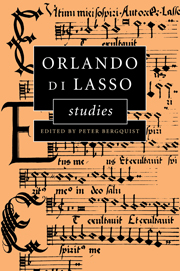Book contents
- Frontmatter
- Contents
- Preface
- List of abbreviations
- 1 Aspects of form in Orlando di Lasso's Magnificat settings
- 2 Orlando di Lasso and Andrea Gabrieli: two motets and their masses in a Munich choir book from 1564–65
- 3 Post-Tridentine liturgical change and functional music: Lasso's cycle of polyphonic Latin hymns
- 4 The salon as marketplace in the 1550s: patrons and collectors of Lasso's secular music
- 5 Lasso's “Standomi un giorno” and the canzone in the mid-sixteenth century
- 6 Lasso's “Fertur in conviviis”: on the history of its text and transmission
- 7 Orlando di Lasso and Rome: personal contacts and musical influences
- 8 Orlando di Lasso as a model for composition as seen in the three-voice motets of Jean de Castro
- 9 The madrigal book of Jean Turnhout (1589) and its relationship to Lasso
- 10 Modal ordering within Orlando di Lasso's publications
- 11 Correct and incorrect accentuation in Lasso's music: on the implied dependence on the text in classical vocal polyphony
- General index
- Index of Lasso compositions and printed sources
3 - Post-Tridentine liturgical change and functional music: Lasso's cycle of polyphonic Latin hymns
Published online by Cambridge University Press: 18 December 2009
- Frontmatter
- Contents
- Preface
- List of abbreviations
- 1 Aspects of form in Orlando di Lasso's Magnificat settings
- 2 Orlando di Lasso and Andrea Gabrieli: two motets and their masses in a Munich choir book from 1564–65
- 3 Post-Tridentine liturgical change and functional music: Lasso's cycle of polyphonic Latin hymns
- 4 The salon as marketplace in the 1550s: patrons and collectors of Lasso's secular music
- 5 Lasso's “Standomi un giorno” and the canzone in the mid-sixteenth century
- 6 Lasso's “Fertur in conviviis”: on the history of its text and transmission
- 7 Orlando di Lasso and Rome: personal contacts and musical influences
- 8 Orlando di Lasso as a model for composition as seen in the three-voice motets of Jean de Castro
- 9 The madrigal book of Jean Turnhout (1589) and its relationship to Lasso
- 10 Modal ordering within Orlando di Lasso's publications
- 11 Correct and incorrect accentuation in Lasso's music: on the implied dependence on the text in classical vocal polyphony
- General index
- Index of Lasso compositions and printed sources
Summary
The study of Orlando di Lasso's polyphonic Latin hymn cycle found one of its earliest stimuli in the work of Julius Joseph Maier (1821–89), the first “Conservator der Musikalischen Abteilung der Kgl. Hof- und Staatsbibliothek,” now the Bayerische Staatsbibliothek. His 1879 catalogue, Die musikalischen Handschriften der K. Hof- und Staatsbibliothek in München, identified three manuscript sources of Lasso's hymn cycle, all of which are still preserved in the Bayerische Staatsbibliothek as Mus. Mss. 55, 75, and 520. In his landmark study of 1958, Wolfgang Boetticher provided a brief overview of the hymn cycle, focusing on questions of dating and authenticity in the oldest manuscript source, Mus. Ms. 55, as well as on its relationship to the two later Munich sources identified by Maier. He also pointed out a fourth source among manuscripts in Augsburg. In her 1980 edition of the hymn cycle, Marie Louise Göllner brought to the fore a fifth manuscript source whose provenance may be traced to Munich's Frauenkirche.
Subsequent to Boetticher's and particularly Göllner's investigation of these sources, and her preparation of a critical edition, a nexus of contextual questions remains to be explored. Why did Lasso compose a hymn cycle in 1580–1? What was the functional context for the creation and use of this repertory? Was there a specific liturgical stimulus? To pose such questions is to assert that beyond source studies, and beyond investigations of musical style and structure, there remain important lines of inquiry regarding the relationship between liturgical rite and musical repertory, and, more broadly, the symbolic role of liturgy within a particular religious culture.
- Type
- Chapter
- Information
- Orlando di Lasso Studies , pp. 41 - 63Publisher: Cambridge University PressPrint publication year: 1999
- 1
- Cited by



